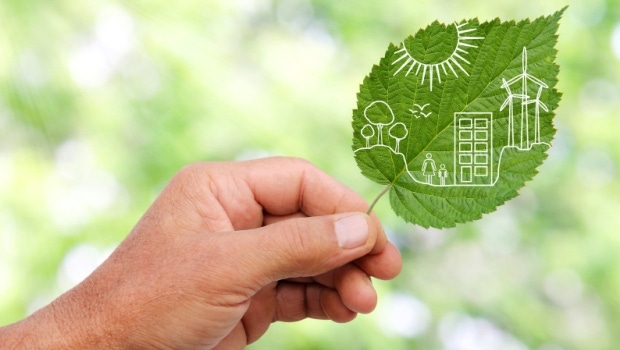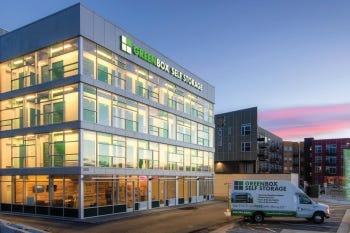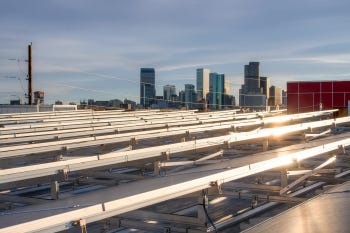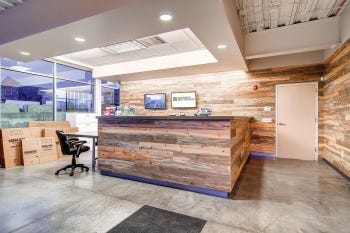Eco-Focus Case Study: Greenbox Self Storage in Denver Adopts Energy-Efficient Approach
The incorporation of green components and initiatives into a self-storage development can reap tangible rewards, from reduced energy costs to greater customer satisfaction. Greenbox uses a dual-pronged strategy to cut its energy expenses and entice eco-minded tenants.
July 30, 2016

By Joshua Fine
There are myriad pitfalls and opportunities in self-storage ownership, but the basic formula for success isn’t complicated—get revenue as high as possible and expenses as low as possible. For most facility operators, the biggest line items on the expense side of the ledger are insurance, marketing, property taxes, utilities and wages, with utility costs often being the best target for trimming the budget. If done right, utility adjustments go unnoticed by your customers or, better yet, can earn their admiration.
One way to do this is by incorporating green building components and initiatives into your facility. Greenbox Self Storage is an environmentally company that operates three properties in Denver and has three more under development. The following outlines how the company uses a dual-pronged strategy to cut its energy expenses and entice eco-minded customers—on one side is increased energy production, on the other is reduced energy consumption.
Energy Production: Solar Panels
 All three Greenbox sites produce energy in-house and are designed to consume less. Each property employs rooftop photovoltaic arrays to generate solar energy that powers facility operation.
All three Greenbox sites produce energy in-house and are designed to consume less. Each property employs rooftop photovoltaic arrays to generate solar energy that powers facility operation.
Solar has become more affordable in recent years, and many storage owners have tapped into rebate and incentive programs to help finance their photovoltaic arrays. The incentives vary from state to state, but many jurisdictions offer a combination of rebates, federal and state tax credits, and ongoing payments from utility  companies. These can help finance the initial expense of an array installation and produce an ongoing revenue stream to boost a facility’s net operating income.
companies. These can help finance the initial expense of an array installation and produce an ongoing revenue stream to boost a facility’s net operating income.
Colorado is blessed with an annual average of 300 days of sunshine, making solar energy efficient and plentiful. If you’re in a market with fewer sunny days, other renewable-energy sources such as wind or geothermal may be better options at your site. Regardless of which you choose, after the initial capital investment, you’ll have a permanent source of free or low-cost energy, which can make a dramatic impact on your energy bill and benefit your facility’s bottom line.
Energy Consumption: Lighting
The other side of the energy equation is consumption. As with production, initial capital investments can yield long-term savings in reduced operating expenses. Greenbox facilities use a combination of lighting technologies to minimize its draw.
The type of lighting used can have a dramatic impact on energy use. LED bulbs are more costly upfront but provide excellent long-term efficiency. Exterior signage is often illuminated throughout the night, so this is a good place to opt for the more expensive LED technology. Fluorescent lights, used in the majority of storage facilities, have also become more efficient. Newer T5 tubes are significantly more efficient than T8s or T12s, and existing ballasts can be retrofitted to accommodate the newer bulbs.
No matter which type of lighting you use, keeping lights off when not needed is often the best way to reduce energy expenses. Consider motion-detection technology that will automatically turn off lights when no motion is detected.
Maximizing the circuits—that’s the bank of lights that are connected to each set of motion detectors—will help make the most of the overall system. If a customer walks down a corridor in your facility, only the lights in that corridor should illuminate. If all the lights on an entire floor turn on each time a customer enters, you’ll be lighting some areas unnecessarily, wasting energy and subjecting your bulbs to wear and tear.
When it comes to side corridors, motion sensors need to be placed deep enough in the corridor so a person walking down a main hallway doesn’t set them off. However, they shouldn’t be placed so deep that customers entering that corridor have to walk several steps in darkness. Walk your facility after the sensors are installed and make adjustments as necessary.
Energy Consumption: Building Design
Heating and cooling are perhaps the biggest factors in determining a facility’s energy consumption. Developers of new facilities should pay heed to the building envelope. Local utilities or energy-consulting firms offer energy audits of proposed designs to help predict a facility’s heating, cooling and lighting needs.
For example, windows allow in natural light, which reduces the need for artificial illumination during the day. However, they also allow solar heat gain into a building and increase cooling costs. Strategic placement of windows to optimize efficiency can help minimize the building’s overall energy needs.
 A smartly designed facility will result in significant energy savings and a reduction in operating expenses without any sacrifice in building performance or comfort. It’s also important to emphasize that it will be appreciated by customers and can help with leasing efforts.
A smartly designed facility will result in significant energy savings and a reduction in operating expenses without any sacrifice in building performance or comfort. It’s also important to emphasize that it will be appreciated by customers and can help with leasing efforts.
Greenbox facilities prominently display, in real time, statistics for their solar-energy production. These display monitors provide a launching point for our management team to engage customers in a conversation about the company’s sustainable initiatives. Placards highlighting the site’s energy-efficient qualities—from dual-flush toilets and LED lighting, to reclaimed beetle-kill pine-wall panels—are also displayed throughout the buildings. Educating customers about our environmentally friendly approach helps to reinforce our brand identity.
As in many markets, customers in Denver are sensitive to issues of energy efficiency and environmental sustainability. Knowing their use of a storage unit at a Greenbox facility has a lighter environmental impact than at a competing property eases their decision to rent with us. While the immediate impact of an energy-efficient facility is lower operating costs, higher occupancy and revenue are often bonus results.
Josh Fine is executive vice president of Focus Property Group LLC, a Denver-based commercial real estate acquisition, development and management firm. Greenbox is the company’s wholly owned brand of self-storage facilities. Focus also develops, owns and operates hospitality, office and retail assets. For more information, visit www.focuspropertygroup.net or www.greenboxselfstorage.com.
You May Also Like





